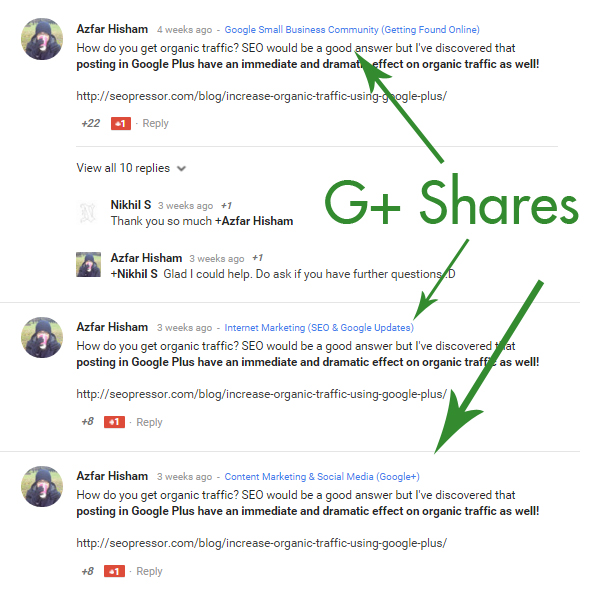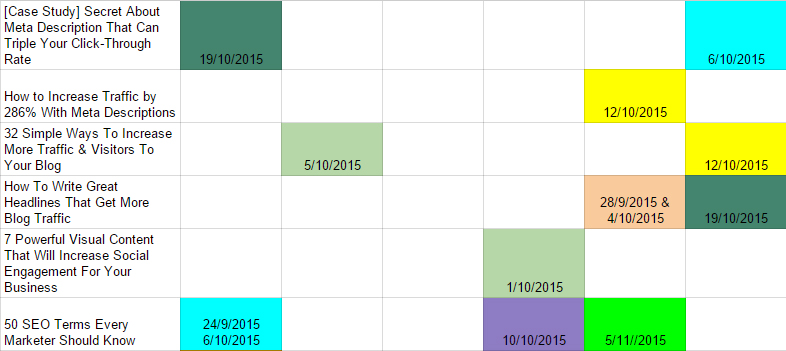Steph W. from SEOPressor


...help you check your website and tell you exactly how to rank higher?


81
score %
SEO Score

Found us from search engine?
We rank high, you can too.
SEOPressor helps you to optimize your on-page SEO for higher & improved search ranking.
By vivian on December 14, 2015

As an SEO Copywriter, it is not enough just to create high quality contents. In order to get your contents noticed and ranked, Content Promotion is necessary. Previously I have written a couple of articles on Content Promotion.
Just to recap, in one of them, I discussed the place and the methods of doing content promotion. In the other, I talked about how promoting my contents managed to get me a massive increase in organic traffic just by using Google Plus Communities.
What can be concluded from both of them is, there are so many places to do content promotion that it is so easy to lose track of each of them. Especially once you start racking up in the amount of contents you have.
So this time, I’ll share how I plan my Content Promotion to get the most out of every content.
You might be asking why is there a need to plan it in the first place. Can’t you just share them whenever you feel like it? To be honest, that’s how I felt in the beginning. At first, content promotion is hardly difficult.
I started off by sharing my posts in my personal social media accounts – Facebook, Twitter, Google Plus and LinkedIn. Remembering 5 places to share your posts once you hit publish is a piece of cake.
But then, I started to found more and more platforms that I can promote on. I discovered online marketer communities such as Inbound and GrowthHackers to share my post with. Later I also stumbled upon a lot of submission-based sites like BizSugar.
To top it off, I learned how to maximize sharing contents on social media by posting on various social media groups like Google Plus Communities, Facebook Groups and LinkedIn Groups. Now this is where things started to really get out of hand.
On Google Plus alone, I already have up to 20 communities to share my contents with. That is not counting other platforms that includes various online communities, social media groups, submission sites as well as my personal and business social media accounts.
One post can easily have more than 50 shareable channels waiting for them.
| For a more complete list of where to do content promotion: Got Awesome Contents? Here’s Where You Should Promote Them”. |
|---|
Now it’s easy to think that you can just share a post to all 50 plus channels the day it is published and be done with it. But it’s highly discouraged and counter-productive for a few reasons:
So the best practice is to distribute your content promotion effort over a longer period of time. You’ll have to limit and plan how many times should a particular contents be shared each day. And for each day, you’ll have to plan which contents gets the priority that day.
A huge number of contents coupled with a huge number of content promotion channels makes it a nightmare to keep track which content have been shared on which platform. And for this reason, we need to carefully craft a plan.
I used to keep track of where a content have been shared by manually checking them. For example, the comments section we have is useful to keep track of which Google Plus Communities they have been shared with.

Initially I use the comments section to track which G+ community have a post been shared.
But checking a huge number of contents is tedious as you have to check each one of them every single time. And going back and forth will make it even more likelier for you to get lost in the middle of it.
To remedy this problem, I have decided to map out the content promotion effort on a single spreadsheet. I used Google Sheets for this. Excel or Open Office would work as well. Here’s how I designed the spreadsheet:
The columns:
Here’s how it looks:

So on the title I listed all of my contents and I linked them for easy access. And the list of all of my content promotion channels are added on the right side of the sheet, also linked. This results in 2 dimensions made out of articles (y axis) and promotion channels (x axis).
Both of them will be expanded when more articles are produced and more promotion channels are discovered.
After you’ve done with setting up the articles and channels, it’s time to track the shares. Every time you share a content on a platform, insert the date of the sharing in the corresponding box.
You can also make good use of colors to help with visualization. There are few different ways of doing this:
If you’re doing this for the first time for your existing contents, it’ll take some effort to track back and plot all of them especially if you have a lot of contents. But rest assured, this is a one-time only process.
Once you’ve done with plotting them, it should look something like this:

White boxes made out of unused content promotion opportunities are easier to notice.
As you can see, it’s now easier to identify “holes” in which you can fill on a daily basis.
There are several benefits to this approach:
Now that you have established the framework of the tracking system, it’s time to decide your day-to-day content promotion planning. Here’s how I promote my contents based every single blog post sorted by priority:
This can usually be done very quickly by using the social share widget we have on our website. It’s a good idea to have these and even if you don’t, posting manually on each account shouldn’t take too long.
You can set it to Tweet your content at least over the next few days after a content is published. It’s important to use different Tweets to link to your content instead of repeating the same one over and over again.
It’s not hard to think of a number of different Tweets to be used. I usually use the discarded alternative titles for an article that I thought of during the writing process.
These usually takes more effort especially community-based websites where you need to carefully choose the suitable time and place to start a discussion.
I usually spread these over the next few days when I have the time. Having the tracker helps me remember which posts haven’t been shared yet.
I start with communities that give the most impact, based on the number of their members and the interaction (Shares, +1s, Likes etc) I usually get out of them. And then I will slowly move to the others as the days go by.
Bear in mind that not all content are suitable for all groups so consideration should be taken based on that. Priorities should also be given to groups that best suit a certain content.
I will link to an article if it is useful to the situation at hand, wherever it may be. Although it goes without saying that I discourage the practice of sharing an article just for the sake of sharing without it being actually useful despite the relevance to a situation.
Content promotion takes a lot of effort but if done right, it can be immensely rewarding. Increased exposure, higher chance to get people linking, more traffic and even better search engine ranking are all potential benefits of doing a proper content promotion.
By closely planning and tracking our content promotion effort, we’ll maximize the benefit we can get out of each and every blog post. Do share if you think you can benefit from my way of planning content promotion and do share how you do yours!
Updated: 26 November 2025


Save thousands of dollars (it’s 100x cheaper)

Zero risk of Google penalty (it’s Google-approved)

Boost your rankings (proven by case studies)
Rank High With This Link Strategy
Precise, Simplified, Fast Internal Linking.
